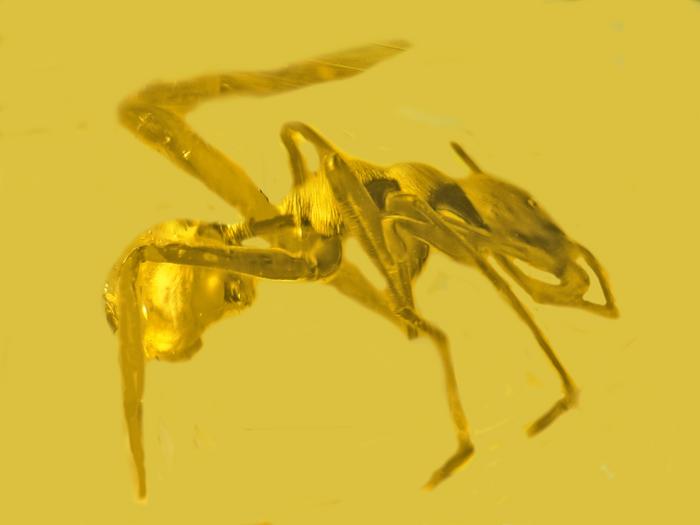To Avoid Predators, This Fossil Spider Posed As An Ant
Posted on Categories Discover Magazine

Though terrifying to people, spiders aren’t always treated with trepidation. Instead, for most of their predators, spiders are a safe snack — a tame and tasty treat — rather than a threat, forcing spiders to follow some pretty strange strategies for self-preservation.
According to a new paper published in Historical Biology, some spiders take a particularly creative approach to protecting themselves from fearless predators, posing as much more threatening creatures: ants. The strategy is so pervasive that it’s sometimes preserved in fossils. The new paper presents a strange specimen that looks a lot like an ant, however, it’s the first specimen of its species and the first ant-mimicking spider trapped in fossilized resin.
“Ants are particularly good creatures for spiders to pretend to be,” says paper author and paleobiologist George Poinar, emeritus professor in the Department of Integrative Biology at Oregon State University, according to a press release. “If a spider can be like an ant, it’s more likely to be unbothered.”
Read More: Why Are We Afraid of Bugs?
Finding Fossil Ant-Mimics
Since the 1800s, it’s been broadly accepted that some spiders disguise themselves as ants, a sound strategy for survival. “Many animals find ants distasteful or dangerous to eat,” Poinar says, according to the release. “Ants are aggressive in their own defense. They have a strong bite as well as a stinging venom, and they can call in dozens of nestmates as allies. Spiders, meanwhile, have no chemical defenses and are loners, which makes them vulnerable to being hunted.”
But while well-recorded in the world today, with some 195 species in a single taxon of ant-mimics called the Myrmarachne, these spiders are not well represented in fossil finds. In fact, in identifying an ant-mimicking spider from Medellin, Colombia, Polinar’s new paper provides the first identification of any ant-mimicking spider found in fossilized resin.
Set in a form of fossil resin called copal, the specimen represents a new species named Myrmarachne colombiana, and is the first ant-mimicking spider from Colombia, whether fossilized or non-fossilized. And while it wasn’t possible to date the resin without risking damage to the spider, the spider’s presence in the material — an intermediary medium, mid-transition into full-fledged amber — means the specimen may be as many as 3 million years old.
Read More: How Smell Holds Ant Societies Together
Turning A Spider Into An Ant
Testifying to the popularity of the ant-mimicking strategy, Polinar’s specimen also tells of the strategy’s sophistication. “Ants have six legs and two long antennae, while spiders have eight legs and no antennae,” the paleobiologist says, according to the release. “It is a challenge for spiders to accomplish this magical transformation to ants.”
To mirror the slender, segmented shape of an ant, ant-mimicking spiders tend to develop a slimmer body than the typical spider, with a bigger separation between their two body segments — their abdomen and their cephalothorax. They also tend to position their appendages in the air to approximate an ant’s probing antennae. It is these adaptations that allow the spiders to avoid predators, including birds and wasps.
According to Polinar, the specimen from Columbia is a Myrmarachne, a member of the Salticidae family, though the Myrmarachne spiders aren’t the only ones to take the shape of fear-inducing insects. While some spiders in the Corinnidae, Thomisidae, and Zodariidae families also mimic ants, other spiders imitate wasps, beetles, and flies — an indication that there are plenty of menacing critters out there, even if spiders aren’t one of them.
Read More: How Ants and Plants Forged A Lasting Partnership
Article Sources:
Our writers at Discovermagazine.com use peer-reviewed studies and high-quality sources for our articles, and our editors review them for accuracy and trustworthiness. Review the sources used below for this article: